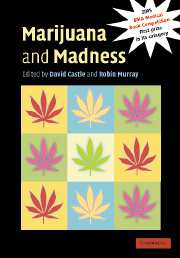Book contents
- Frontmatter
- Contents
- List of contributors
- Foreword
- Preface
- 1 The cannabinoid system: from the point of view of a chemist
- 2 How cannabis works in the brain
- 3 Acute and subacute psychomimetic effects of cannabis in humans
- 4 The association between cannabis use and depression: a review of the evidence
- 5 Cannabis and psychosis proneness
- 6 Is there a specific ‘cannabis psychosis’?
- 7 Cannabis as a potential causal factor in schizophrenia
- 8 Cannabis abuse and the course of schizophrenia
- 9 The endogenous cannabinoid system in schizophrenia
- 10 Cannabinoid ‘model’ psychosis, dopamine–cannabinoid interactions and implications for schizophrenia
- 11 Motives that maintain cannabis use among individuals with psychotic disorders
- 12 Addressing cannabis abuse in people with psychosis
- 13 Residual cognitive effects of long-term cannabis use
- Index
- References
11 - Motives that maintain cannabis use among individuals with psychotic disorders
Published online by Cambridge University Press: 07 December 2009
- Frontmatter
- Contents
- List of contributors
- Foreword
- Preface
- 1 The cannabinoid system: from the point of view of a chemist
- 2 How cannabis works in the brain
- 3 Acute and subacute psychomimetic effects of cannabis in humans
- 4 The association between cannabis use and depression: a review of the evidence
- 5 Cannabis and psychosis proneness
- 6 Is there a specific ‘cannabis psychosis’?
- 7 Cannabis as a potential causal factor in schizophrenia
- 8 Cannabis abuse and the course of schizophrenia
- 9 The endogenous cannabinoid system in schizophrenia
- 10 Cannabinoid ‘model’ psychosis, dopamine–cannabinoid interactions and implications for schizophrenia
- 11 Motives that maintain cannabis use among individuals with psychotic disorders
- 12 Addressing cannabis abuse in people with psychosis
- 13 Residual cognitive effects of long-term cannabis use
- Index
- References
Summary
Rather than attempt to explain fully the complex relationship between cannabis and psychosis, this chapter focuses on what drives people with psychotic disorders to continue their cannabis use. Regardless of what precipitated the cannabis use, it is important to understand what maintains it or why individuals with psychotic disorders continue to use it, despite the negative impact that cannabis use may be having on their mental state. Understanding the motivation for cannabis use may provide insight into the circumstances in which the individual will use substances, the amount consumed, possible consequences and ideal strategies for behaviour change (Simons et al., 1998). This insight can inform psychological treatments that attempt to reduce that use, as well as adjunctive pharmacological treatment and other aspects of psychiatric rehabilitation.
There are various factors to be considered in understanding why people with psychotic disorders continue to use cannabis. These include: (1) level of insight into both their mental illness and the effects of cannabis on symptoms; (2) biological drives for cannabis use (e.g. dopaminergic); (3) genetic or learned family influences; (4) sociocultural influences; (5) impact of affective/psychotic symptoms; (6) personality variables and coping strategies; and (7) addiction. It is argued, however, that the final common pathway or motivation to use cannabis is (8) the expectations of the direct and indirect effects cannabis use will have on affect.
- Type
- Chapter
- Information
- Marijuana and MadnessPsychiatry and Neurobiology, pp. 166 - 185Publisher: Cambridge University PressPrint publication year: 2004



